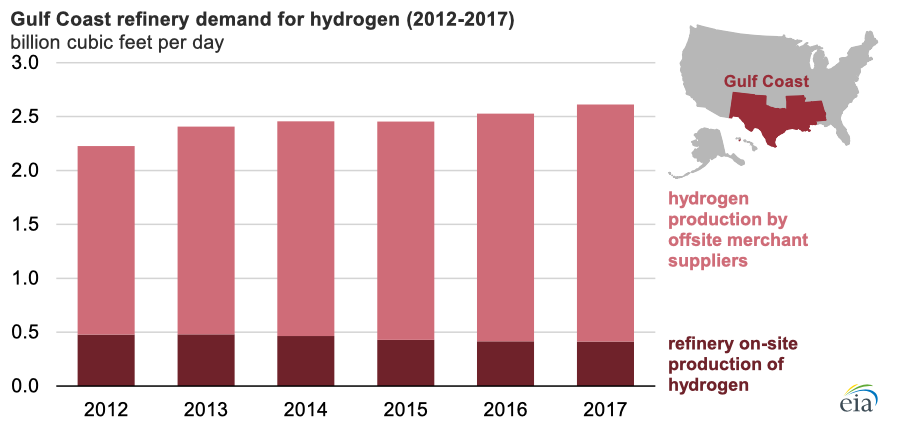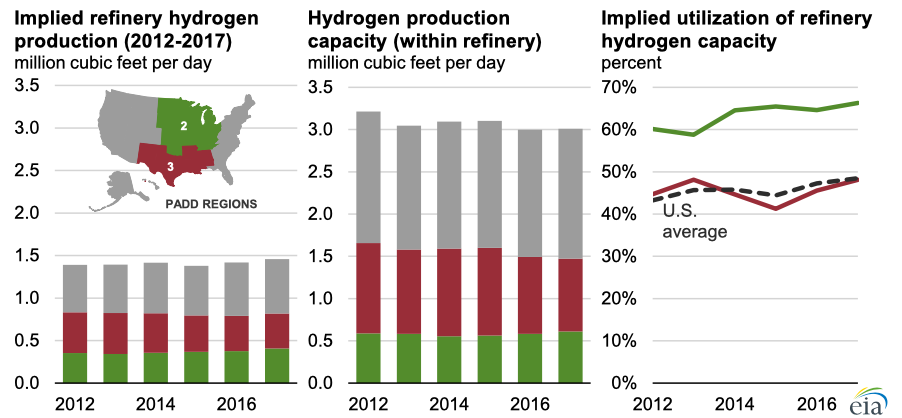Petroleum refineries in the U.S. Gulf Coast increasingly rely on merchant suppliers, rather than their own production, to provide the hydrogen used to reduce the sulfur content of fuel. As global demand for distillate fuel oil has increased and sulfur content regulations have become more stringent, refineries have needed to use more hydrogen. Hydrogen demand is expected to continue to rise as International Maritime Organization regulations that limit the sulfur content in marine fuels take effect on January 1, 2020.

Petroleum refineries use hydrogen in downstream units, such as hydrocrackers and hydrotreaters, to meet fuel specifications for producing distillate, jet fuel, and other petroleum products. Hydrogen is particularly important in processing low-grade, sour crude slates that are rich in sulfur content. Refineries typically fulfill incremental hydrogen demand by either producing it on-site through steam reforming of natural gas or by purchasing it from merchant suppliers.
As demand for hydrogen increases, U.S. Gulf Coast refiners (those in Petroleum Administration for Defense District 3) are consuming more hydrogen from merchant suppliers than from their own production. Between 2012 and 2017, consumption of hydrogen sourced from merchant suppliers increased from about 1,750 million cubic feet per day (MMcf/d) to 2,200 MMcf/d, a 25% increase. Over the same period, on-site production of hydrogen from natural gas fell from about 475 MMcf/d to 415 MMcf/d, a 13% decrease. Merchant suppliers accounted for more than 85% of hydrogen consumed by refineries in 2017.
The increased use of purchased hydrogen by U.S. Gulf Coast refineries is a response to limitations on the amount of hydrogen that can be produced on-site compared with the supply of hydrogen provided by merchant suppliers. A large share of hydrogen used by U.S. Gulf Coast refineries is supplied by a 600-mile, one billion cubic foot per day network of hydrogen pipelines stretching from Lake Charles, Louisiana, to Houston, Texas.
Industrial hydrogen is produced in two ways: on-purpose hydrogen production using steam methane reformer (SMR) units or as a by-product of other chemical processes. Natural gas is used almost exclusively as feedstock for on-purpose hydrogen production in petroleum refinery SMR units in the United States, but refiners also collect and use by-product hydrogen from their own catalytic reformer units. EIA only collects data on hydrogen produced by SMR units.
Between 2012 and 2017, U.S. Gulf Coast petroleum refineries increased hydrocracking capacity by 50%, with a similar increase in distillate production. Over the same time, SMR capacity decreased by 19%, leading refiners to purchase more hydrogen from merchant suppliers.

Refineries located in the Midwest United States (PADD 2) have increased hydrocracking capacity by 13% from 2012 to 2017. Unlike U.S. Gulf Coast refiners, Midwest refiners historically have not been as reliant on merchant suppliers because of a lack of dedicated hydrogen pipelines. Some Midwestern refiners use more Canadian, sour crude oil, which requires more hydrogen to process. Overall, the utilization of U.S. Gulf Coast refinery SMR units has been between 41% and 48%, while in the Midwest it has risen from 60% in 2012 to 66% in 2017.
Principal contributors: Peter Gross, Matthew Skelton

Follow us on social media: